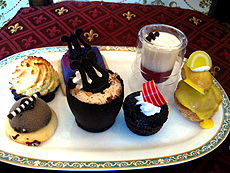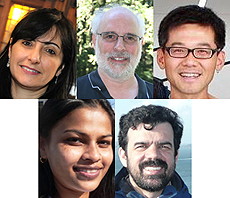Higgs boson a la carte?
 |
| Finding additional Higgs bosons predicted by theories beyond the Standard Model at the Large Hadron Collider would be a very sweet treat for particle physicists around the world. Photo courtesy of Marcela Carena, PPD |
The discovery of the Higgs boson on July 4, 2012, at the Large Hadron Collider made a huge splash in the public media. I was fortunate to be at the solemn, glamorous Nobel Prize ceremony and to listen to Peter Higgs and Francois Englert's behind-the-scenes look at the origins of the Higgs idea half a century ago.
In physics there is a long history of powerful ideas enabling profound discoveries; the Higgs story is a perfect example of such a synergy. It took thousands of people from dozens of nations and the largest, most complex, most expensive machine ever built to manufacture the Higgs boson — an amazing, successful story of theory guiding experiments.
What lies beyond the Higgs boson? Particle physicists around the world are eagerly awaiting the second run of the LHC, which will begin in a few months and produce lots of new data.
The Fermilab Theory Group is working hard on generating novel ways of unlocking the mysteries of nature through the upcoming LHC data. We are expecting new particles to be discovered; they may point toward an additional symmetry of nature, such as supersymmetry, or reveal that the Higgs particle is a composite of other constituents — we need experiments to guide theory. Some of these new particles may be related to dark matter, and some may point to an explanation of the matter-antimatter asymmetry — an enigma that has absorbed me professionally for the last 20 years. Many of these ideas have in common the existence of a generous menu of additional Higgs particles.
In supersymmetry, at least four new Higgs bosons are required. These new Higgs particles could be directly produced and observed in the next run of the LHC. Moreover, the LHC will produce millions of the already discovered Higgs boson and measure its properties with precision. Even small departures from the expected values could be an indication of the existence of other types of Higgs particles.
In a recent paper, my collaborators and I showed the importance of both measuring the properties of the Higgs boson we know and searching for supersymmetric Higgs bosons to understand the physics that is responsible for the masses of the elementary particles in nature.
Discovering additional Higgs bosons may be our next window to a new world. Nobody can anticipate how many sweet treats may be available in the new run of the LHC, but we will soon find out.
—Marcela Carena
 |
| These scientists are responsible for this analysis. Top row, from left: Marcela Carena (Fermilab, University of Chicago), Howard Haber (University of California, Santa Cruz), Ian Low (Northwestern University, Argonne National Laboratory). Bottom row, from left: Nausheen Shah (University of Michigan), Carlos Wagner (University of Chicago, Argonne National Laboratory). |
|